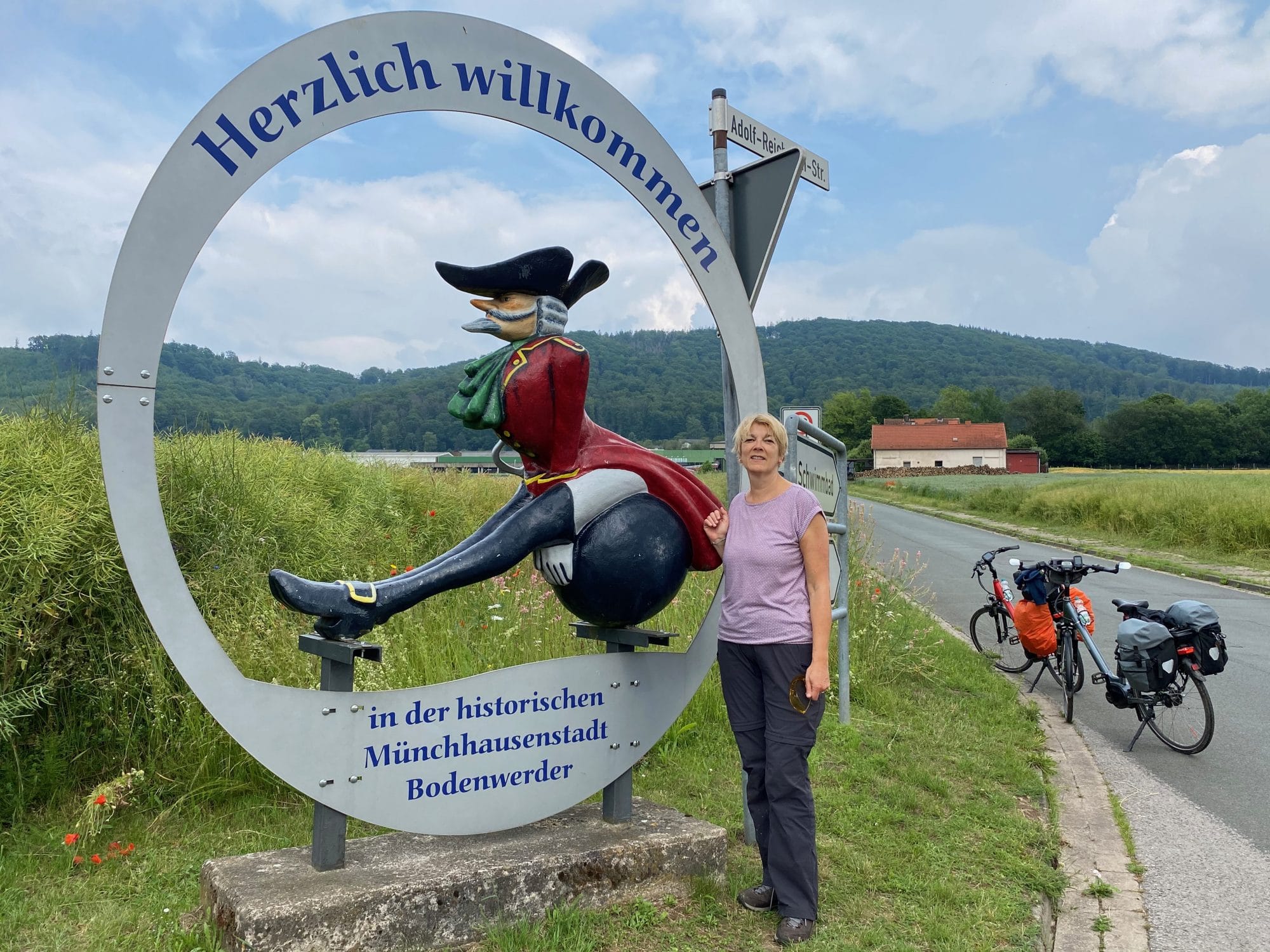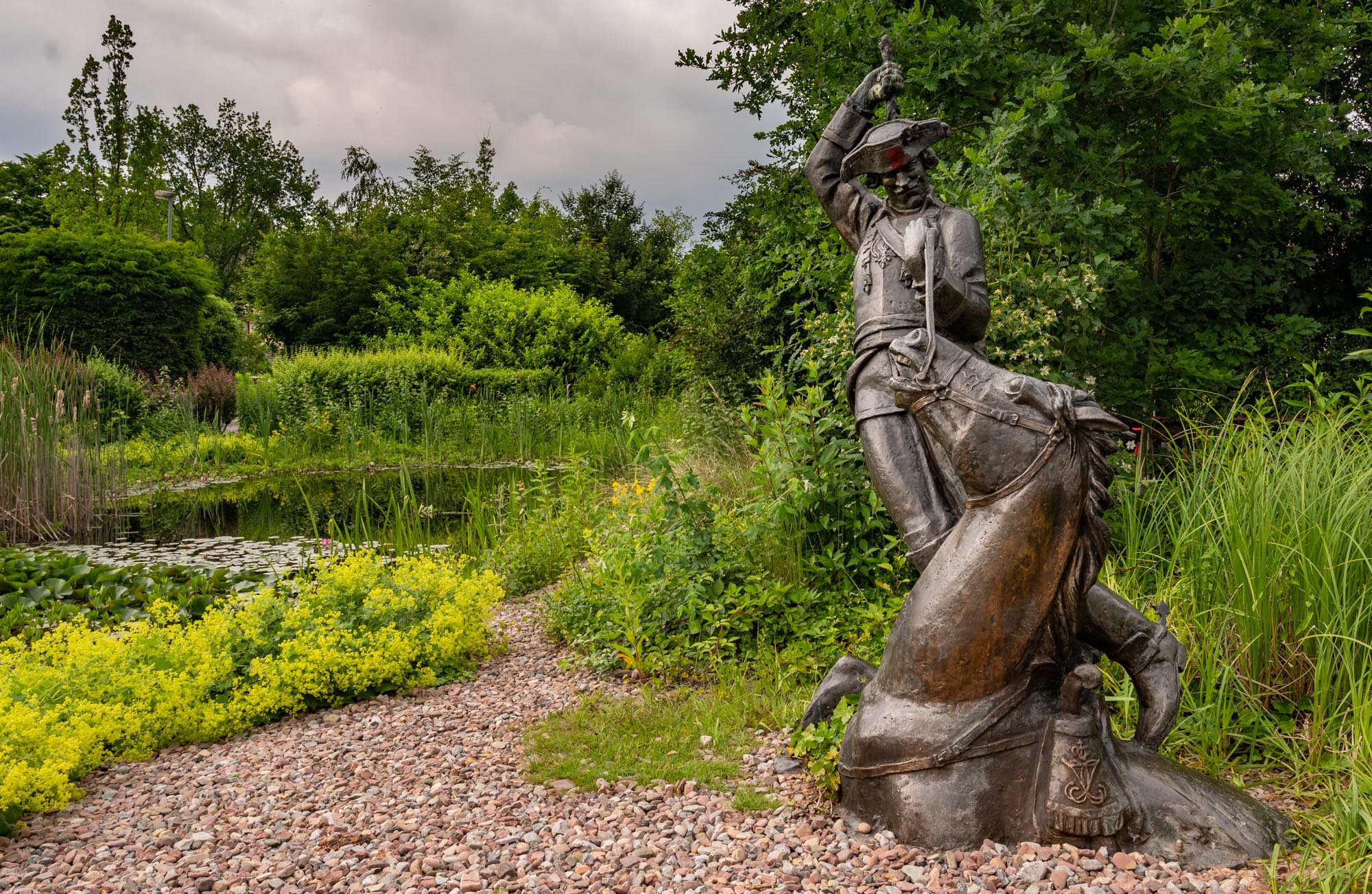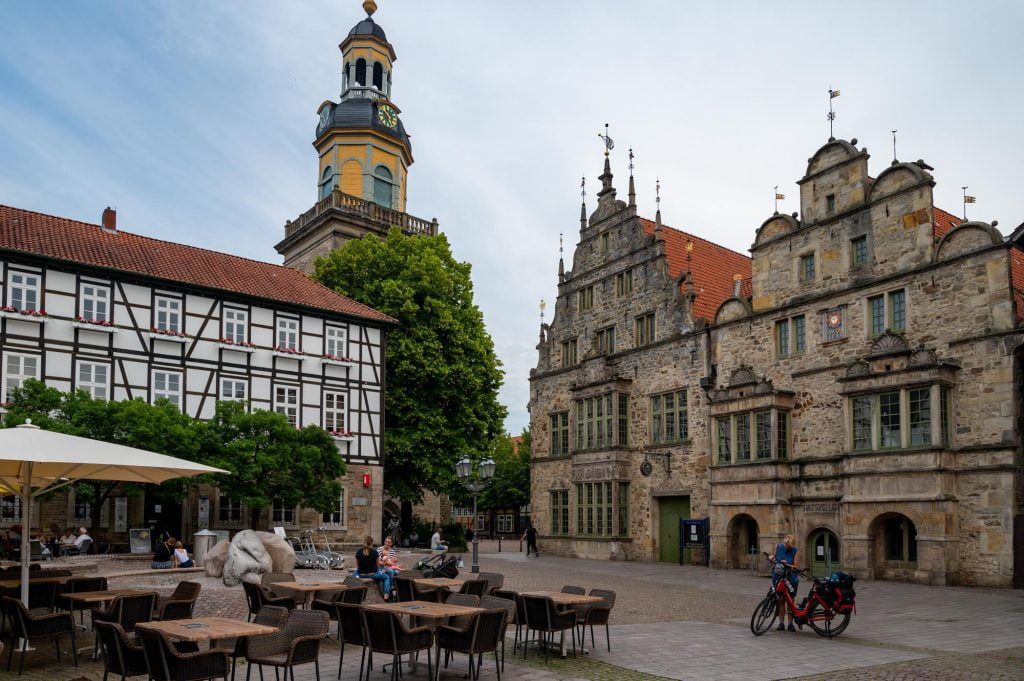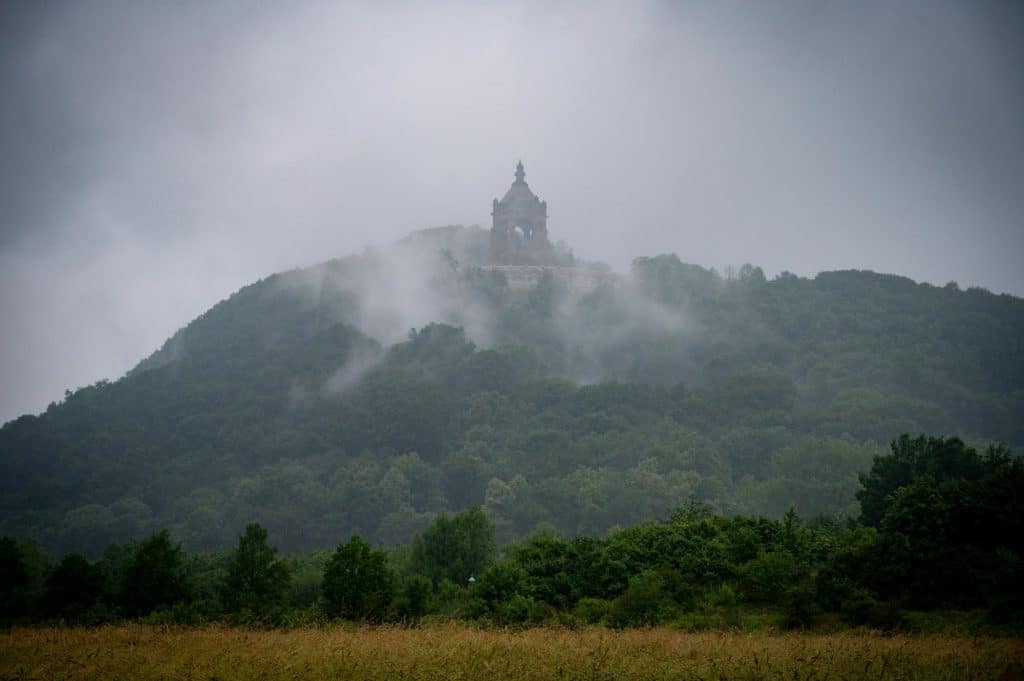Back in 2019 B.C – Before Coronavirus, as we were thinking about 2020s bike trip, we decided on the Moldau river route in the Czech Republic. Then the corona hit the fan and traveling out of the country was risky, so we looked for something in Germany. The Weser river bike route was on our list, so we decided that 2020 would be the year of the Weser. Germany, and the individual states, had loosened up on their travel restrictions for their citizens in late spring, so we felt comfortable taking the trip in June.
The Weserradweg, as it is called in German, runs from Hannoversch-Münden to Cuxhaven on the North Sea Coast. We started planning this trip like we do all others. We look for an organized bike tour from a company, see where they stop, then make our own plans based on that. We found hotels along our route easily enough, but the prices had gone up a bit. Not really a surprise to see.
The route travels through two geographic regions, a hilly region called the Weserbergland which extends from the start of the river in the south to Petershagen. Then comes the flatland, mostly farms until it empties in the North Sea.
So, our trip began in Hannoversch-Münden, aka Hann. Münden. We arrived in town on June 14th after a 2-hour train ride. Hann. Münden is a picturesque town of half-timbered houses where the Fulda and the Wera rivers meet and join to form the Weser. A famous stone marks the spot of the marriage, the poem on the stone reads:
Where Werra and Fulda kiss
They have to give up their names
And it creates through this kiss
German until the sea the Weser River

June 15th – The journey begins
The weather didn’t cooperate with us on our first day. We had a light, but steady rain most of the day. We brought enough wet weather gear to keep us dry from the knees up, but unfortunately, our shoes and feet were completely wet after a few hours. Be that as it may, we enjoyed the day. A few hours into the ride we stopped at the 923-year-old Benedictine Monastery in Bursfelde. The church was open for visitors but other than that there wasn’t much to see.

While there, we met an elderly woman who was also riding the Weserradweg. After a brief chat, she mentioned that she will stay in Beverungen, and even in the same hotel as us – Hotel Stadt Bremen. After a few more minutes of conversation, we said goodbye and went our separate ways.
Leaving the monastery, we continued the journey to the typically picturesque village of Beverungen, stopping along the way for some geocaches. We arrived in town at about 3pm. Shortly after we arrived, we bumped into…her… again. The woman from the monastery. She gave us her impressions of the town and after a few minutes of conversation, we each went our way again. Sightseeing in Beverungen takes roughly 20 minutes. A walk around the village center and you’re done. The rest of the town is just like any other.
After a substantial breakfast, we set off. We were expecting some rain but were pleasantly surprised with the dry, but overcast weather. Perfect for being out all day. Cool, dry, no worries about sunburn. We had lunch at Holzminden, a city known for its fragrances. There are smelling stations throughout the town. It was an interesting tour and a treat for the nose. We also stopped at the UNESCO World Heritage Site Corvey Palace/Abbey in Höxter. Upon arrival, we bumped into none other than..her. She said she was unimpressed with the Abbey. We had a look for ourselves. Turns out she was right, it was ok, we were “whelmed”.
We ended the day in Bodenwerder. A town with an interesting history. It’s the home of Baron von Münchhausen, a former Army officer with a flair for storytelling. A writer used his stories to create a fictional version of the Baron as a notorious liar. In his most famous story, he claims that he sat on a canon, and when the cannonball shot out, he rode it through the air. In another, he claimed that he and his horse fell into some quicksand. He rescued himself and his horse by pulling himself out by his hair.
We stayed in an almost completely unimpressive hotel in Hehlen, just a few kilometers from Bodenwerder, Landgasthaus Hoffmeister. It was, to put it nicely, rustic. Our first stop, after dropping off our bags, was the hotel restaurant. An elderly woman sat us at a table. After taking our drink order, we noticed that she was a bit grumpy. During our second encounter with her, when she took our dinner order, we realized that she wasn’t unfriendly; she was mostly deaf. Once we spoke up her disposition improved immensely.
There were two couples in the restaurant who were also riding the Weser bike tour, sitting at the table next to us. They seemed a friendly bunch and a couple of times we exchanged a comment. The approaching ominous sky turned the discussion to the weather and whether to move inside. We both decided to stay put. Perhaps it will blow over. After the first few raindrops fell, the two couples moved inside. We, however, stayed outside. A few times over the next several minutes, one of the two men would come back out to check the situation outside – they seemed unsure about their decision to move inside. During one of these checks, and seeing us sitting very relaxed at our table, the man jokingly offered a bet. If they move back outside, we win 20 Euros. If we move inside, they win. After about 20 minutes the rain came, which forced us to move inside. Seeing us, the two men proudly informed us we owe them 20 Euros. We all had a friendly laugh.
Once back in our room I noticed right away that our bedsheets were very rough and suspected it was a mattress cover.
“I think they forgot to put sheets on the bed,” I told Kathrin.
“No, these are terrycloth sheets. A common sheet…30 years ago. If they dry on the clothesline, they get hard and feel rough.”
Whatever the cause, my arms and legs had a complete exfoliation overnight.
Breakfast the next morning was basic but satisfying. Grandma, who was very pleasant and much more talkative, brought everything to the table.
Today’s route was removed from the Weser, there were only a few kilometers where we saw it. What it lacked in river views it made up for in alternative sites.
First of these was Schloß Hämelschenburg, built between 1588 and 1613. We had a look at the grounds and took some photos, but we couldn’t tour the palace. It was closed because of Coronavirus. Nonetheless, it was a worthwhile stop.
From there we visited the Damenstift in Frischbeck. Founded in 955, it’s a religious community for women who live in a monastery-like complex without taking vows.
Soon afterward we were in Hameln, the town made famous with the story of the Pied Piper. Unsurprisingly many businesses took advantage of the town’s history and used “rat” in their name or logo. Stuffed rats were a popular souvenir item. While wandering around town we bumped into “her” again. As has become our tradition she gave us her impressions of Hameln and after a brief exchange, we both continued our walks. We found her to be friendly, but we began to notice that she was hard to please. Her impressions were almost always slightly underwhelming.
We ended the day in Rinteln. It doesn’t have a famous story associated with it, but has a very nice town hall and market square. As we entered the town, we saw our hotel. The site of it made us nervous. It was a boring rectangle. No charm to it at all. It looked like a low budget tourist trap. We decided to have dinner before checking in, so we continued into town at one of the restaurants in the market square. En route, we bumped into her again. We exchanged the usual chit chat and said goodbye.
Once at the hotel, the friendliness of the staff overcame any reservations we had about the appearance. They were friendly and service-minded. When we checked in they took our bikes to their garage. The next day our bikes were waiting for us in the lobby after breakfast. These people really give their best for their guests.
Day 5 – The wettest day of our trip. It rained the entire day. And not the light, drizzly rain like last time. This was a real rain, the kind that makes you stay inside. Unfortunately, we had no such option. We put on our rain jackets and knee-length leg-covers and set off. There are many ways in which rain makes a bike tour less enjoyable and more stressful. Not only were our shoes soaked, but our bike seats would get wet every time we stopped for a geocache. Also, looking for the cache is a bit more unpleasant when the area is wet and muddy. Nonetheless, we persevered, but our motivation for sightseeing was down to about 0 and we forced ourselves to keep going. I stopped for a photo a couple of times and fortunately, the rain took a brief pause when I came to this photo spot.

It was on this day that we passed through Porta Westfalica. Kathrin had mentioned this as the place where there is a monument worth seeing. “OK, fine. We can stop there and see it,” I remember thinking to myself. Now here we were, and the weather was terrible. We were soaking wet from the rain, and the foggy mist in the air didn’t allow us to see the monument. It was just a shadowy silhouette. Kathrin was very disappointed. But then we came around a bend in the bike path and the monument was visible. I took a photo, and we continued on.
In my first draft of this blog post, I neglected to mention this monument. When Kathrin proof read it she commented on this. “The monument is a big deal in Germany. It’s very well known and worth mentioning.”
Ok, so I looked it up. Yep, its kind of a thing. One of Germany’s national monuments, the Emperor Wilhelm Monument (Kaiser Wilhelm Denkmal) is a tribute to Germany’s first emperor. Passing this by is like driving through Keystone, South Dakota and not stopping to see Mount Rushmore.
There came a point when the rain broke us. The swimming pools our feet were bathing in, my wet pants, the raindrops falling on Kathrin’s GPS’s touch screen, and making it go haywire was too much. We abandoned geocaching; we forgot about sightseeing, and we went to a bike store for some proper rain pants and shoe covers. One day as a drowned rat was too much. We want to be better protected in the future. The only chance we had was in Minden, a medium-sized town not too far away. After a brief stop for lunch, we searched google maps for a store. Once there, we bought shoe covers and short rain pants, to the tune of 180 euros. We didn’t care, the peace of mind it gave us was worth the price.
A short ride later we were at our hotel. The Pension Rad – Haus (“Pension Bike-House”) in Petershagen was an oasis after our unpleasant ride. I’m sure we looked like drowned rats upon our arrival, but the host was kind enough not to notice – or at least comment. As the name implies, this pension caters to bikers. We had a large, comfortable room. Next door to us was a common kitchen equipped with a single-cup coffee maker, water kettle, and a selection of cold drinks.
After changing into dry clothes and hanging our wet clothes above the radiators, we walked a few doors down the street to get dinner. The rain had just about stopped, but we still were not willing to venture too far to find a restaurant. We had two choices, a pizzeria with an uninviting seating area, or a Turkish döner shop that was only serving take away. We chose the döner place and took it back to the common kitchen.
The next morning we met the hosts, a man and wife team, at breakfast. Both were friendly. The wife was a very sociable person. She chatted everyone up during breakfast. Her knowledge of the Weser bike route was impressive. To our surprise, she correctly guessed our last hotel and our next one.
After a pleasant breakfast, we packed up, mounted our bikes, and took advantage of the sunny weather to see something of Petershagen. We toured around and did a little geocaching before bidding the town goodbye and continuing on our trip. I’ll save that for part 2, so stay tuned!








Leave a Reply